SDM: Site-to-Site IPsec VPN Between ASA/PIX and an IOS Router Configuration Example
Available Languages
Contents
Introduction
This document provides a sample configuration for the LAN-to-LAN (Site-to-Site) IPsec tunnel between Cisco Security Appliances (ASA/PIX) and a Cisco IOS Router. Static routes are used for simplicity.
Refer to PIX/ASA 7.x Security Appliance to an IOS Router LAN-to-LAN IPsec Tunnel Configuration Example in order to learn more about the same scenario where the PIX/ASA Security Appliance runs software version 7.x.
Prerequisites
Requirements
Ensure that you meet these requirements before you attempt this configuration:
-
End-to-End IP connectivity must be established before starting this configuration.
-
The Security Appliance license must be enabled for Data Encryption Standard (DES) encryption (at a minimum encryption level).
Components Used
The information in this document is based on these software and hardware versions:
-
Cisco Adaptive Security Appliance (ASA) with version 8.x and later
-
ASDM version 6.x.and later
-
Cisco 1812 router with Cisco IOS® Software Release 12.3
-
Cisco Security Device Manager (SDM) Version 2.5
Note: Refer to Allowing HTTPS Access for ASDM in order to allow the ASA to be configured by the ASDM.
Note: Refer to Basic Router Configuration using SDM in order to allow the router to be configured by SDM.
The information in this document was created from the devices in a specific lab environment. All of the devices used in this document started with a cleared (default) configuration. If your network is live, make sure that you understand the potential impact of any command.
Note: Refer to Configuration Professional: Site-to-Site IPsec VPN Between ASA/PIX and an IOS Router Configuration Example for a similar configuration using Cisco Configuration Professional on the router.
Related Products
This configuration can also be used with the Cisco PIX 500 Series Security Appliance, which runs version 7.x and later.
Conventions
Refer to the Cisco Technical Tips Conventions for more information on document conventions.
Configuration
Network Diagram
This document uses the network setup shown in this diagram.
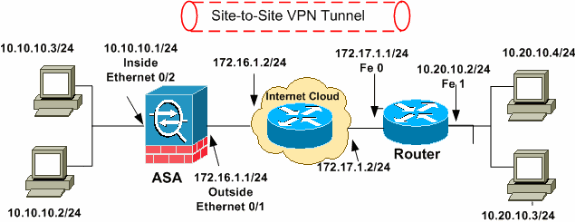
Note: The IP addressing schemes used in this configuration are not legally routable on the Internet. They are RFC 1918 ![]() addresses, which have been used in a lab environment.
addresses, which have been used in a lab environment.
VPN Tunnel ASDM Configuration
Complete these steps in order to create the VPN tunnel:
-
Open your browser and enter https://<IP_Address of the interface of ASA that has been configured for ASDM Access> to access the ASDM on the ASA.
Make sure to authorize any warnings your browser gives you related to SSL certificate authenticity. The default username and password are both blank.
The ASA presents this window to allow the download of the ASDM application. This example loads the application onto the local computer and does not run in a Java applet.
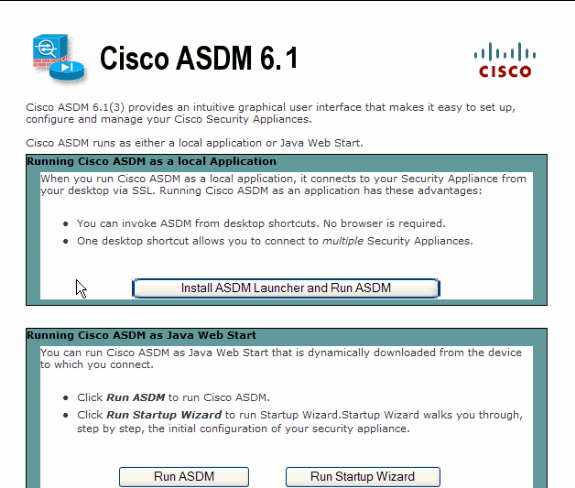
-
Click Download ASDM Launcher and Start ASDM in order to download the installer for the ASDM application.
-
Once the ASDM Launcher downloads, complete the steps directed by the prompts in order to install the software and run the Cisco ASDM Launcher.
-
Enter the IP address for the interface you configured with the http - command, and a username and password if you specified one.
This example uses cisco123 for the username and cisco123 as the password.
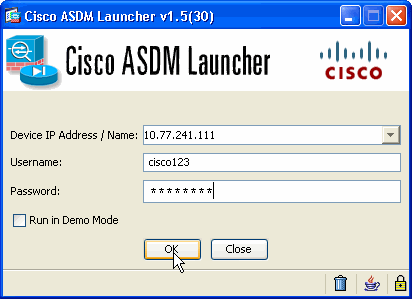
-
Run the IPsec VPN Wizard once the ASDM application connects to the ASA.
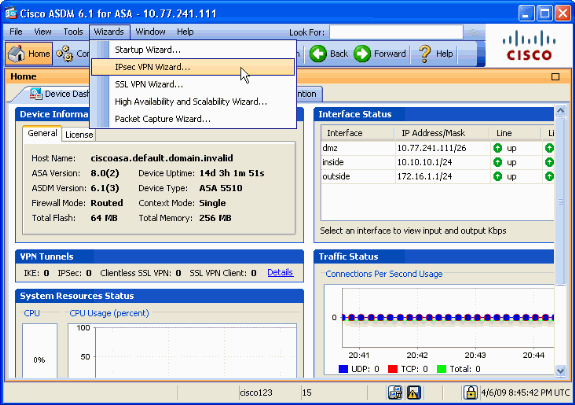
-
Choose the Site-to-Site IPsec VPN tunnel type and click Next as shown here.
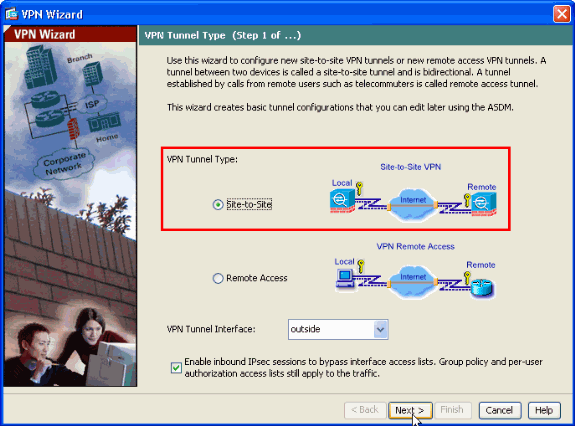
-
Specify the outside IP address of the remote peer. Enter the authentication information to use, which is the pre-shared key in this example. The pre-shared key used in this example is cisco123. The Tunnel Group Name will be your outside IP address by default if you configure L2L VPN. Click Next.
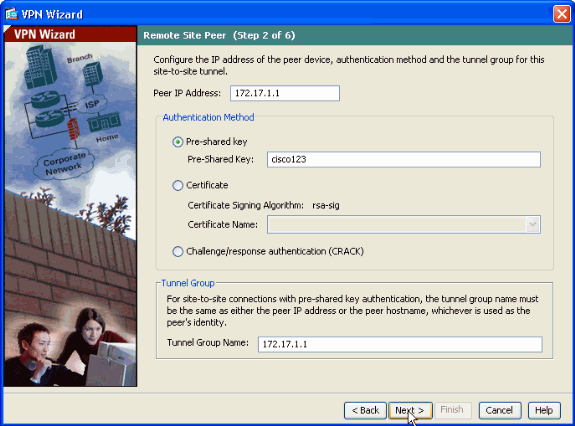
-
Specify the attributes to use for IKE, also known as Phase 1. These attributes must be the same on both the ASA and the IOS Router. Click Next.
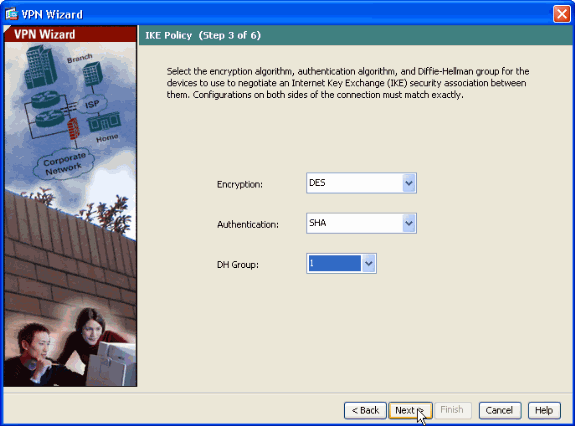
-
Specify the attributes to use for IPsec, also known as Phase 2. These attributes must match on both the ASA and the IOS Router. Click Next.
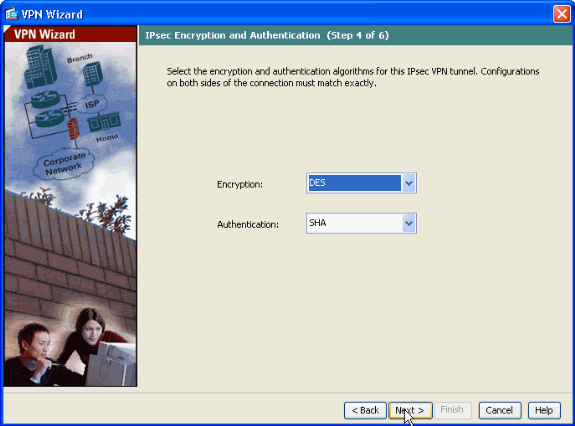
-
Specify the hosts whose traffic should be allowed to pass through the VPN tunnel. In this step, you have to provide the Local and Remote Networks for the VPN Tunnel. Click the button next to Local Networks as shown here to choose the local network address from the drop down list.
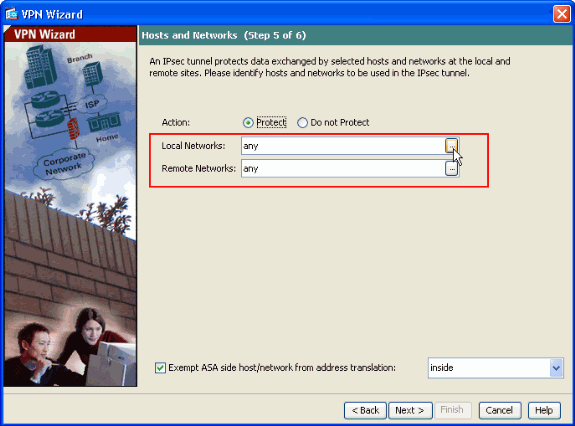
-
Choose the Local Network address, then click OK as shown here.
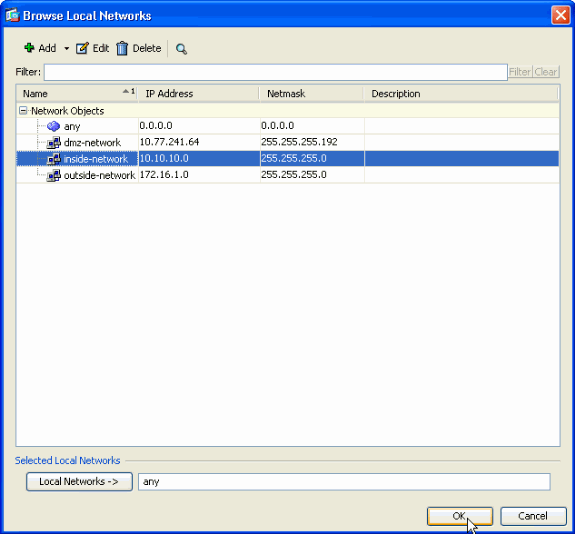
-
Click the button next to Remote Networks as shown here to choose the remote network address from the drop down list.
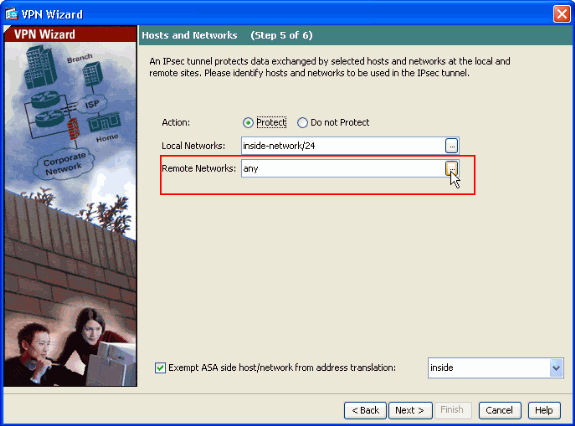
-
Choose the Remote Network address, then click OK as shown here.
Note: If you do not have the Remote Network in the list then the network has to be added to the list by clicking Add.
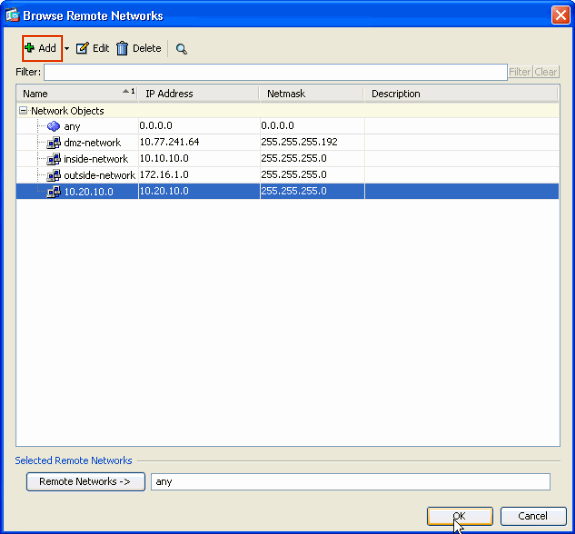
-
Check the Exempt ASA side host/network from address translation checkbox in order to prevent the tunnel traffic from undergoing Network Address Translation. Then, click Next.
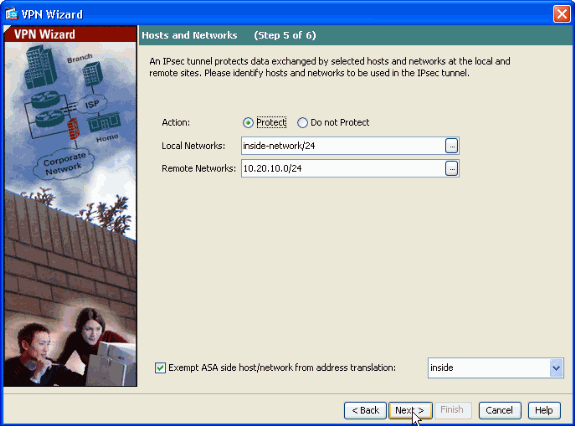
-
The attributes defined by the VPN Wizard are displayed in this summary. Double check the configuration and click Finish when you are satisfied the settings are correct.
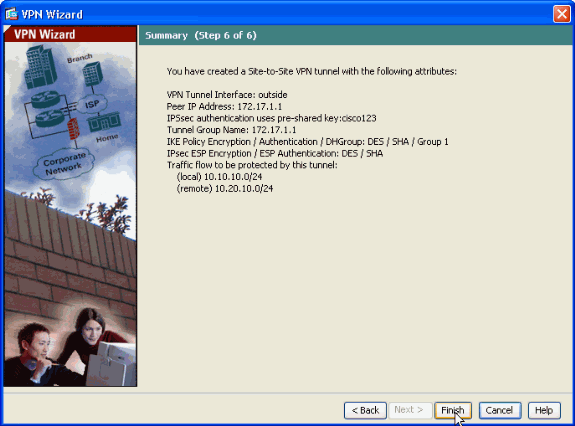
Router SDM Configuration
Complete these steps in order to configure Site-to-Site VPN Tunnel on the Cisco IOS Router:
-
Open your browser and enter https://<IP_Address of the interface of the Router that has been configured for SDM Access> to access the SDM on the Router.
Make sure to authorize any warnings your browser gives you related to SSL certificate authenticity. The default username and password are both blank.
The router presents this window to allow the download of the SDM application. This example loads the application onto the local computer and does not run in a Java applet.
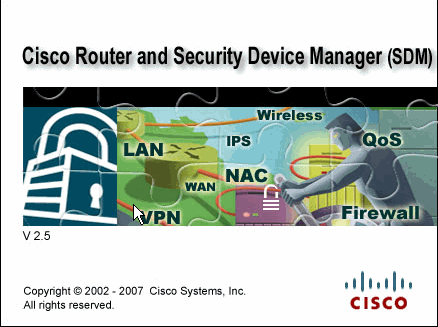
-
The SDM download starts now. Once the SDM Launcher downloads, complete the steps directed by the prompts in order to install the software and run the Cisco SDM Launcher.
-
Enter the Username and Password if you specified one and click OK.
This example uses the cisco123 for the username and cisco123 as the password.
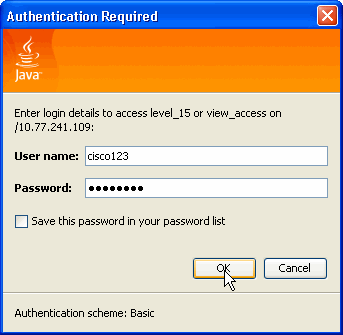
-
Choose Configuration->VPN->Site-to-Site VPN and click the radio button next to Create a Site-to-Site VPN on the SDM home page. Then, click Launch The selected Task as shown here:
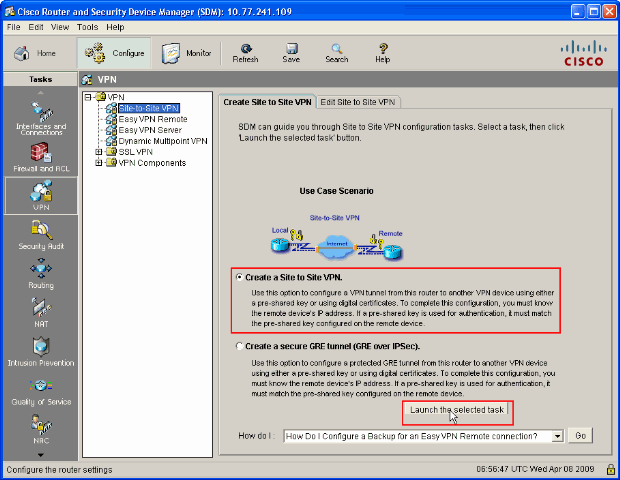
-
Choose Step by step wizard to proceed with the configuration:
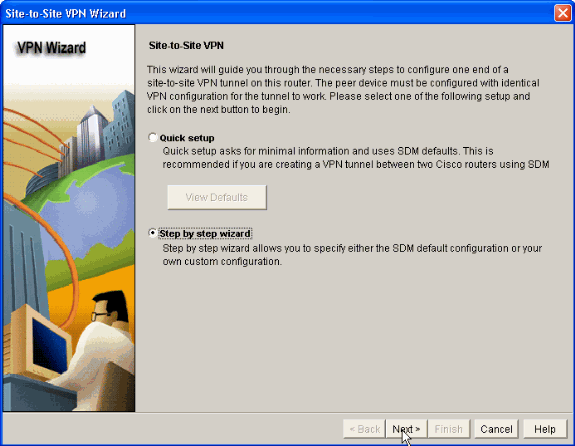
-
In the next window provide the VPN Connection Information in the respective spaces. Select the Interface of the VPN Tunnel from the drop down list. Here, FastEthernet0 is chosen. In the Peer Identity section, choose Peer with static IP address and provide the remote peer IP address. Then, provide the Pre-shared key (cisco123 in this example) in the Authentication section as shown . Then, click Next.
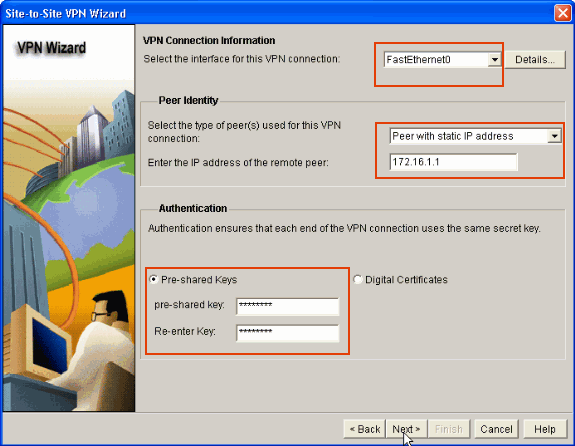
-
Click Add to add IKE proposals which specifies the Encryption Algorithm, Authentication Algorithm and the Key Exchange Method.
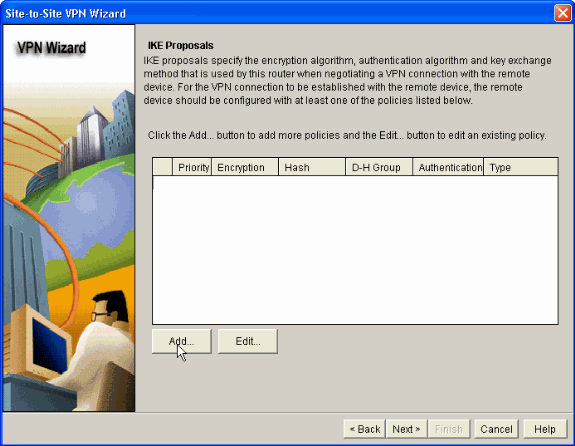
-
Provide Encryption Algorithm, Authentication Algorithm and the Key Exchange method as shown here, then click OK. The Encryption Algorithm, Authentication Algorithm and the Key Exchange method values should match with the data provided in the ASA.
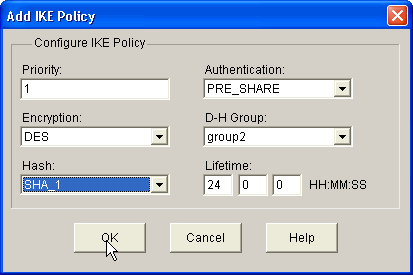
-
Click Next as shown here.
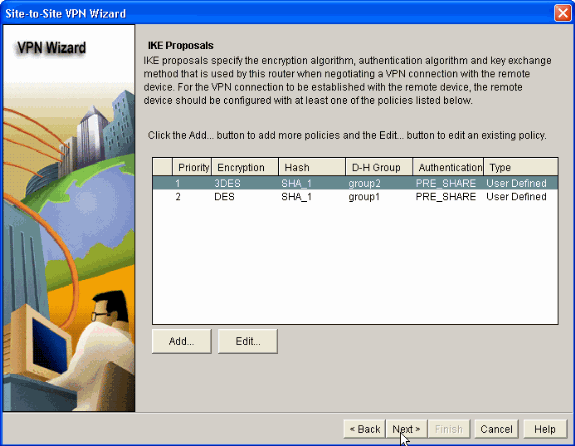
-
In this new window the Transform Set details should be provided. The Transform Set specifies the Encryption and Authentication algorithms used to protect Data in VPN Tunnel. Then, click Add to provide these details. You can add any number of Transform Sets as needed by clicking Add and providing the details.
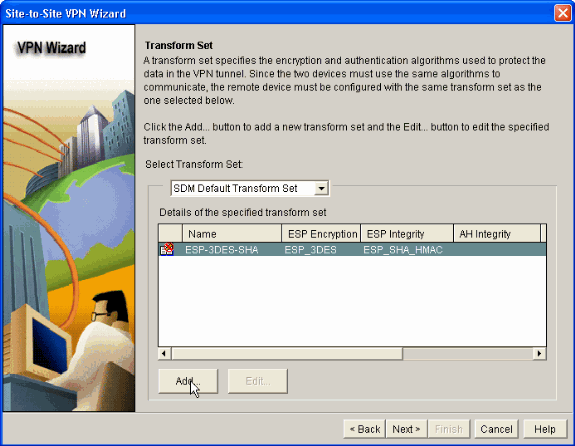
-
Provide the Transform Set details (Encryption and Authentication Algorithm) and click OK as shown.
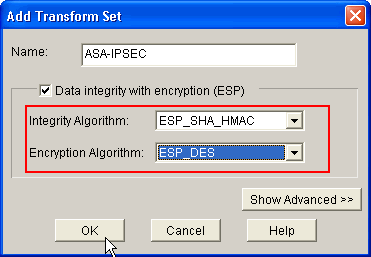
-
Choose the required Transform Set to be used from the drop down list as shown.
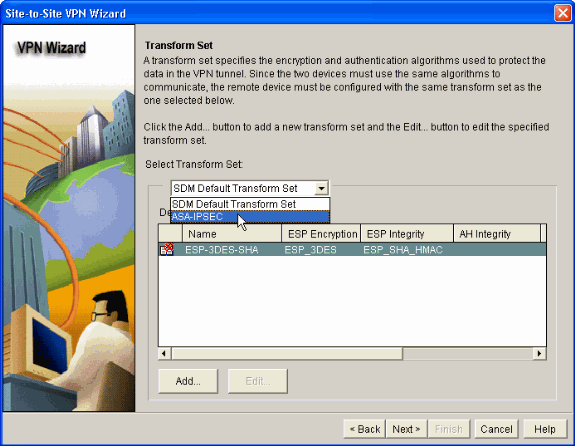
-
Click Next.
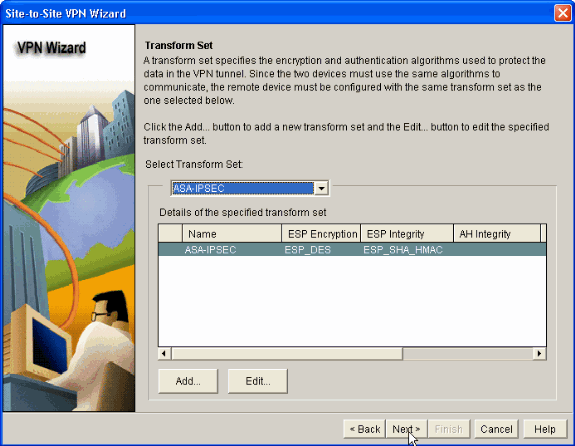
-
In the following window provide the details about the Traffic to be protected through the VPN Tunnel. Provide the Source and Destination Networks of the traffic to be protected so that the traffic between the specified source and destination networks are protected. In this example, the Source network is 10.20.10.0 and the Destination network is 10.10.10.0. Then, click Next.
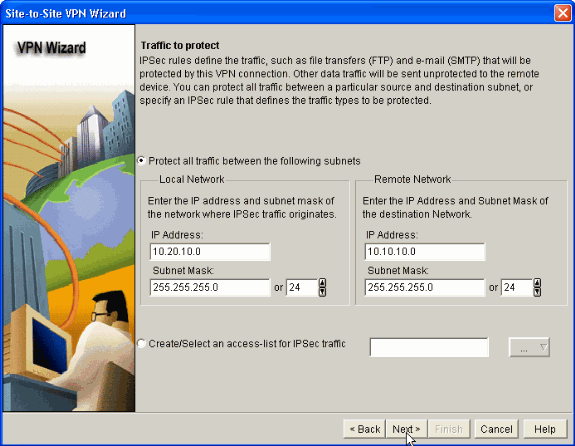
-
This window shows the summary of the Site-to-Site VPN configuration done. Check the Test VPN Connectivity after configuring check box if you want to test the VPN connectivity. Here, the box is checked as the connectivity needs to be checked. Then, click Finish.
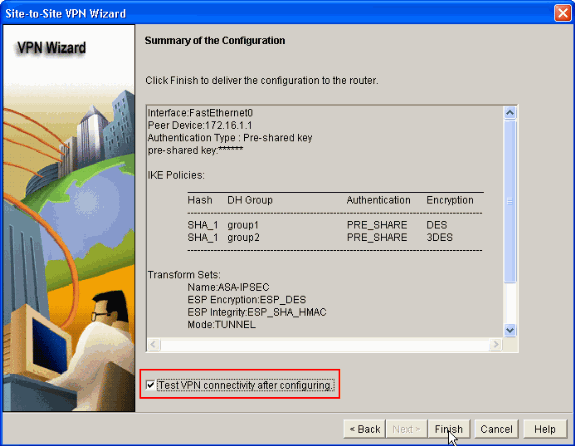
-
Click Start as shown to check the VPN connectivity.
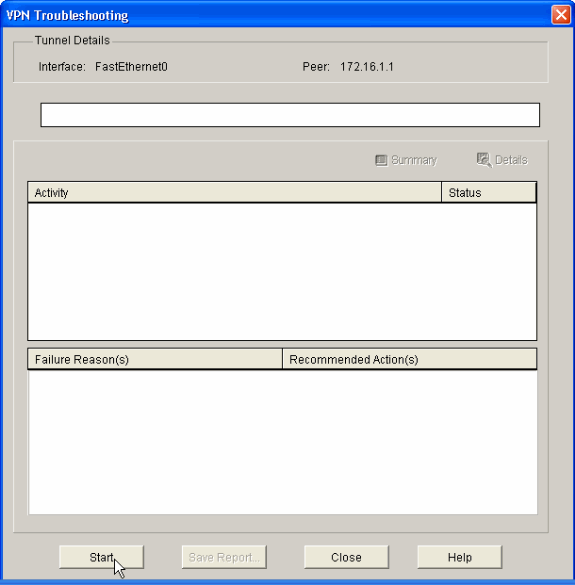
-
In the next window the result of the VPN connectivity Test is provided. Here, you can see if the tunnel is Up or Down. In this example configuration, the Tunnel is Up as shown in green.

This completes the configuration on the Cisco IOS Router.
ASA CLI Configuration
| ASA |
|---|
ASA#show run : Saved ASA Version 8.0(2) ! hostname ASA enable password 8Ry2YjIyt7RRXU24 encrypted names ! !--- Configure the outside interface. ! interface Ethernet0/1 nameif outside security-level 0 ip address 172.16.1.1 255.255.255.0 !--- Configure the inside interface. ! interface Ethernet0/2 nameif inside security-level 100 ip address 10.10.10.1 255.255.255.0 !-- Output suppressed ! passwd 2KFQnbNIdI.2KYOU encrypted ftp mode passive dns server-group DefaultDNS domain-name default.domain.invalid access-list 100 extended permit ip any any access-list inside_nat0_outbound extended permit ip 10.10.10.0 255.255.255.0 10.20.10.0 255.255.255.0 !--- This access list (inside_nat0_outbound) is used !--- with the nat zero command. This prevents traffic which !--- matches the access list from undergoing network address translation (NAT). !--- The traffic specified by this ACL is traffic that is to be encrypted and !--- sent across the VPN tunnel. This ACL is intentionally !--- the same as (outside_1_cryptomap). !--- Two separate access lists should always be used in this configuration. access-list outside_1_cryptomap extended permit ip 10.10.10.0 255.255.255.0 10.20.10.0 255.255.255.0 !--- This access list (outside_cryptomap) is used !--- with the crypto map outside_map !--- to determine which traffic should be encrypted and sent !--- across the tunnel. !--- This ACL is intentionally the same as (inside_nat0_outbound). !--- Two separate access lists should always be used in this configuration. pager lines 24 mtu inside 1500 mtu outside 1500 no failover asdm image disk0:/asdm-613.bin asdm history enable arp timeout 14400 global (outside) 1 interface nat (inside) 1 10.10.10.0 255.255.255.0 nat (inside) 0 access-list inside_nat0_outbound !--- NAT 0 prevents NAT for networks specified in !--- the ACL inside_nat0_outbound. access-group 100 in interface outside route outside 0.0.0.0 0.0.0.0 172.16.1.2 1 timeout xlate 3:00:00 timeout conn 1:00:00 half-closed 0:10:00 udp 0:02:00 icmp 0:00:02 timeout sunrpc 0:10:00 h323 0:05:00 h225 1:00:00 mgcp 0:05:00 timeout mgcp-pat 0:05:00 sip 0:30:00 sip_media 0:02:00 timeout uauth 0:05:00 absolute http server enable http 0.0.0.0 0.0.0.0 dmz no snmp-server location no snmp-server contact !--- PHASE 2 CONFIGURATION ---! !--- The encryption types for Phase 2 are defined here. crypto ipsec transform-set ESP-DES-SHA esp-des esp-sha-hmac !--- Define the transform set for Phase 2. crypto map outside_map 1 match address outside_1_cryptomap !--- Define which traffic should be sent to the IPsec peer. crypto map outside_map 1 set peer 172.17.1.1 !--- Sets the IPsec peer crypto map outside_map 1 set transform-set ESP-DES-SHA !--- Sets the IPsec transform set "ESP-AES-256-SHA" !--- to be used with the crypto map entry "outside_map". crypto map outside_map interface outside !--- Specifies the interface to be used with !--- the settings defined in this configuration. !--- PHASE 1 CONFIGURATION ---! !--- This configuration uses isakmp policy 10. !--- The configuration commands here define the Phase !--- 1 policy parameters that are used. crypto isakmp enable outside crypto isakmp policy 10 authentication pre-share encryption des hash sha group 1 lifetime 86400 telnet timeout 5 ssh timeout 5 console timeout 0 threat-detection basic-threat threat-detection statistics access-list ! tunnel-group 172.17.1.1 type ipsec-l2l !--- In order to create and manage the database of connection-specific !--- records for ipsec-l2l—IPsec (LAN-to-LAN) tunnels, use the command !--- tunnel-group in global configuration mode. !--- For L2L connections the name of the tunnel group MUST be the IP !--- address of the IPsec peer. tunnel-group 172.17.1.1 ipsec-attributes pre-shared-key * !--- Enter the pre-shared-key in order to configure the !--- authentication method. telnet timeout 5 ssh timeout 5 console timeout 0 threat-detection basic-threat threat-detection statistics access-list ! class-map inspection_default match default-inspection-traffic ! ! !-- Output suppressed! username cisco123 password ffIRPGpDSOJh9YLq encrypted privilege 15 Cryptochecksum:be38dfaef777a339b9e1c89202572a7d : end |
Router CLI Configuration
| Router |
|---|
Building configuration... Current configuration : 2403 bytes ! version 12.3 service timestamps debug datetime msec service timestamps log datetime msec service password-encryption ! hostname R3 ! boot-start-marker boot-end-marker ! no logging buffered ! username cisco123 privilege 15 password 7 1511021F07257A767B no aaa new-model ip subnet-zero ! ! ip cef ! ! ip ips po max-events 100 no ftp-server write-enable ! !--- Configuration for IKE policies. !--- Enables the IKE policy configuration (config-isakmp) !--- command mode, where you can specify the parameters that !--- are used during an IKE negotiation. Encryption and Policy details are hidden as the default values are chosen. crypto isakmp policy 2 authentication pre-share !--- Specifies the pre-shared key "cisco123" which should !--- be identical at both peers. This is a global !--- configuration mode command. crypto isakmp key cisco123 address 172.16.1.1 ! ! !--- Configuration for IPsec policies. !--- Enables the crypto transform configuration mode, !--- where you can specify the transform sets that are used !--- during an IPsec negotiation. crypto ipsec transform-set ASA-IPSEC esp-des esp-sha-hmac ! !--- !--- Indicates that IKE is used to establish !--- the IPsec Security Association for protecting the !--- traffic specified by this crypto map entry. crypto map SDM_CMAP_1 1 ipsec-isakmp description Tunnel to172.16.1.1 !--- !--- Sets the IP address of the remote end. set peer 172.16.1.1 !--- !--- Configures IPsec to use the transform-set !--- "ASA-IPSEC" defined earlier in this configuration. set transform-set ASA-IPSEC !--- !--- Specifies the interesting traffic to be encrypted. match address 100 ! ! ! !--- Configures the interface to use the !--- crypto map "SDM_CMAP_1" for IPsec. interface FastEthernet0 ip address 172.17.1.1 255.255.255.0 duplex auto speed auto crypto map SDM_CMAP_1 ! interface FastEthernet1 ip address 10.20.10.2 255.255.255.0 duplex auto speed auto ! interface FastEthernet2 no ip address ! interface Vlan1 ip address 10.77.241.109 255.255.255.192 ! ip classless ip route 10.10.10.0 255.255.255.0 172.17.1.2 ip route 10.77.233.0 255.255.255.0 10.77.241.65 ip route 172.16.1.0 255.255.255.0 172.17.1.2 ! ! ip nat inside source route-map nonat interface FastEthernet0 overload ! ip http server ip http authentication local ip http secure-server ! !--- Configure the access-lists and map them to the Crypto map configured. access-list 100 remark SDM_ACL Category=4 access-list 100 remark IPSec Rule access-list 100 permit ip 10.20.10.0 0.0.0.255 10.10.10.0 0.0.0.255 ! ! ! !--- This ACL 110 identifies the traffic flows using route map access-list 110 deny ip 10.20.10.0 0.0.0.255 10.10.10.0 0.0.0.255 access-list 110 permit ip 10.20.10.0 0.0.0.255 any route-map nonat permit 10 match ip address 110 ! control-plane ! ! line con 0 login local line aux 0 line vty 0 4 privilege level 15 login local transport input telnet ssh ! end |
Verify
Use this section to confirm that your configuration works properly.
The Output Interpreter Tool (registered customers only) (OIT) supports certain show commands. Use the OIT to view an analysis of show command output.
ASA/PIX Security Appliance - show Commands
-
show crypto isakmp sa—Shows all current IKE SAs at a peer.
ASA#show crypto isakmp sa Active SA: 1 Rekey SA: 0 (A tunnel will report 1 Active and 1 Rekey SA during rekey) Total IKE SA: 1 1 IKE Peer: 172.17.1.1 Type : L2L Role : initiator Rekey : no State : MM_ACTIVE -
show crypto ipsec sa—Shows all current IPsec SAs at a peer.
ASA#show crypto ipsec sa interface: outside Crypto map tag: outside_map, seq num: 1, local addr: 172.16.1.1 local ident (addr/mask/prot/port): (10.10.10.0/255.255.255.0/0/0) remote ident (addr/mask/prot/port): (10.20.10.0/255.255.255.0/0/0) current_peer: 172.17.1.1 #pkts encaps: 9, #pkts encrypt: 9, #pkts digest: 9 #pkts decaps: 9, #pkts decrypt: 9, #pkts verify: 9 #pkts compressed: 0, #pkts decompressed: 0 #pkts not compressed: 9, #pkts comp failed: 0, #pkts decomp failed: 0 #pre-frag successes: 0, #pre-frag failures: 0, #fragments created: 0 #PMTUs sent: 0, #PMTUs rcvd: 0, #decapsulated frgs needing reassembly: 0 #send errors: 0, #recv errors: 0 local crypto endpt.: 172.16.1.1, remote crypto endpt.: 172.17.1.1 path mtu 1500, ipsec overhead 58, media mtu 1500 current outbound spi: 434C4A7F inbound esp sas: spi: 0xB7C1948E (3082917006) transform: esp-des esp-sha-hmac none in use settings ={L2L, Tunnel, PFS Group 2, } slot: 0, conn_id: 12288, crypto-map: outside_map sa timing: remaining key lifetime (kB/sec): (4274999/3588) IV size: 8 bytes replay detection support: Y outbound esp sas: spi: 0x434C4A7F (1129073279) transform: esp-des esp-sha-hmac none in use settings ={L2L, Tunnel, PFS Group 2, } slot: 0, conn_id: 12288, crypto-map: outside_map sa timing: remaining key lifetime (kB/sec): (4274999/3588) IV size: 8 bytes replay detection support: Y
Remote IOS Router - show Commands
-
show crypto isakmp sa—Shows all current IKE SAs at a peer.
Router#show crypto isakmp sa dst src state conn-id slot status 172.17.1.1 172.16.1.1 QM_IDLE 3 0 ACTIVE
-
show crypto ipsec sa—Shows all current IPsec SAs at a peer.
Router#show crypto ipsec sa interface: FastEthernet0 Crypto map tag: SDM_CMAP_1, local addr 172.17.1.1 protected vrf: (none) local ident (addr/mask/prot/port): (10.20.10.0/255.255.255.0/0/0) remote ident (addr/mask/prot/port): (10.10.10.0/255.255.255.0/0/0) current_peer 172.16.1.1 port 500 PERMIT, flags={origin_is_acl,} #pkts encaps: 68, #pkts encrypt: 68, #pkts digest: 68 #pkts decaps: 68, #pkts decrypt: 68, #pkts verify: 68 #pkts compressed: 0, #pkts decompressed: 0 #pkts not compressed: 0, #pkts compr. failed: 0 #pkts not decompressed: 0, #pkts decompress failed: 0 #send errors 0, #recv errors 0 local crypto endpt.: 172.17.1.1, remote crypto endpt.: 172.16.1.1 path mtu 1500, ip mtu 1500 current outbound spi: 0xB7C1948E(3082917006) inbound esp sas: spi: 0x434C4A7F(1129073279) transform: esp-des esp-sha-hmac , in use settings ={Tunnel, } conn id: 2001, flow_id: C18XX_MBRD:1, crypto map: SDM_CMAP_1 sa timing: remaining key lifetime (k/sec): (4578719/3004) IV size: 8 bytes replay detection support: Y Status: ACTIVE inbound ah sas: inbound pcp sas: outbound esp sas: spi: 0xB7C1948E(3082917006) transform: esp-des esp-sha-hmac , in use settings ={Tunnel, } conn id: 2002, flow_id: C18XX_MBRD:2, crypto map: SDM_CMAP_1 sa timing: remaining key lifetime (k/sec): (4578719/3002) IV size: 8 bytes replay detection support: Y Status: ACTIVE outbound ah sas: outbound pcp sas: -
show crypto engine connections active—Shows current connections and information about encrypted and decrypted packets (router only).
Router#show crypto engine connections active ID Interface IP-Address State Algorithm Encrypt Decrypt 3 FastEthernet0 172.17.1.1 set HMAC_SHA+DES_56_CB 0 0 2001 FastEthernet0 172.17.1.1 set DES+SHA 0 59 2002 FastEthernet0 172.17.1.1 set DES+SHA 59 0
Troubleshoot
This section provides information you can use to troubleshoot your configuration.
The Output Interpreter Tool (registered customers only) (OIT) supports certain show commands. Use the OIT to view an analysis of show command output.
Note: Refer to Important Information on Debug Commands and IP Security Troubleshooting - Understanding and Using debug Commands before you use debug commands.
-
debug crypto ipsec 7—Displays the IPsec negotiations of phase 2.
debug crypto isakmp 7—Displays the ISAKMP negotiations of phase 1.
-
debug crypto ipsec—Displays the IPsec negotiations of phase 2.
debug crypto isakmp—Displays the ISAKMP negotiations of phase 1.
Refer to Most Common L2L and Remote Access IPSec VPN Troubleshooting Solutions for more information on troubleshooting Site-Site VPN.
Related Information
- Cisco PIX Firewall Software
- Cisco Adaptive Security Device Manager
- Cisco ASA 5500 Series Adaptive Security Appliances
- Configuration Professional: Site-to-Site IPsec VPN Between ASA/PIX and an IOS Router Config Example
- Cisco Secure PIX Firewall Command References
- Cisco Router and Security Device Manager
- Requests for Comments (RFCs)

- Technical Support & Documentation - Cisco Systems
Revision History
| Revision | Publish Date | Comments |
|---|---|---|
1.0 |
08-Apr-2009 |
Initial Release |
Contact Cisco
- Open a Support Case

- (Requires a Cisco Service Contract)





























 Feedback
Feedback